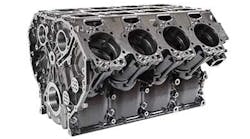THE RECENT KUBOTEK USA (www.kubotek.com) CAD Interoperability Survey identified serious problems with sharing CAD files between and within companies (See American Machinist, December, 2006, pg. 16 or www.americanmachinist.com/304/Issue/Article/ False/43809/Issue). The Kubotek survey said about 95 percent of the 2,869 respondents reported serious interoperability problems. Translator issues and missing or corrupt data were the two most frequently cited factors.
Apparently many of those respondents are not familiar with or have not had a chance to use Autodesk's DWF format for sharing CAD data. That is surprising, because free software to read and write DWF format files is available for download at the compay's website (www.autodesk.com/dwf-publishing).
DWF is an acronym for Design Web Format. It was created in the mid 1990s as a way to share designs via the Internet, and originally was called Drawing Web Format. The format enabled complex drawings to be expressed in less than a megabyte of storage (an early web browser limitation on transfer file size). The ability to share DWF files via the Internet became so popular with Autodesk users that Autodesk made it an output option in all of its design applications. Eventually the name was changed to Design Web Format to more accurately reflect the primary purpose and use of the file format.
Today, DWF has gone beyond being an easy way to share design data via the Internet and has become a solid and easyto-use foundation for complete product-lifecycle management. A designer creates a 2D or 3D drawing of a product in whatever native file format he or she prefers then outputs a copy of that drawing in DWF format for sharing with other designers, customers, suppliers and shop floor personnel. Other documents such as text files, spreadsheets, photographs and PDF format files can be added to the DWF file and then distributed. All of the documents in the DWF file can be viewed using the free reader. To mark up the documents you need to use Autodesk's Design Review software, which sells for less than $200.
After marking up the file, the documents can be sent via email back to the designer who then makes the changes on the original native format file, generates a new DWF file and distributes that for review. During all of this sharing and review the original drawings remain secure and unchanged except by the original designer.
A DWF file is a 3D information model, not a picture of a model. That means you can turn and manipulate the model, zoom in and out without having the image get fuzzy, and have the ability to get accurate measurement directly from the model even if the designer never listed them on the original drawing. You can even automate a drawing to show how a product is assembled or how it operates. You can also embed hyperlinks in the file to connect documents and drawings in the file or stored elsewhere and available via the Internet. You can do text searches and you can print files on any printer.
Internet users are familiar with Portable Document Format (PDF) files. DWF is a similar format designed for sharing rich engineering design data the same way that a way PDF file is for textural-based document exchange. PDF files are limited to 2,400 dots per inch (dpi) resolution, while DWF files are more than two billion dpi. DWF files can contain substantial design intelligence, including sheet, object, component and mass properties as well as markup data. PDFs don't. The PDF format is a generic solution to exchanging textual data while DWF is specifically designed to exchange meaningful CAD data.
So how useful is it on the shop floor? "Our machinists use DWF format files for a number of reasons," said Patrik Chartrand, CAD and IT manager for Advanced Dynamics (www.advanceddynamics.com). "For example, a designer may not put all the dimensions a machinist needs on a drawing, but our machinists can go to a workstation on the shop floor and pull his own dimensions from the DWF drawing instead of having to ask the engineer or designer to do it for him. Also, just by being able to look at the drawing, move it around in 3D, the machinist can get a better idea of how to machine the part and which tools to use. This is a completely different approach than working with a 2D drawing, and it is saving us a lot of time and effort out on the shop floor."
In five years, Advanced Dynamics has gone from a completely paper shop to a completely 3D shop. Design reviews that used to take more than a week because of the delays caused by shipping drawings back and forth are now done in hours, sometimes in minutes, via DWF files and the Internet or email.
The DWF format and open access software associated with it is already having a profound effect on shops that are using it. In fact, an enormous number of DWF files are already available for viewing via the Internet. Try a Google search using "filetype:dwf USA," and you will get more than 500 DWF files of various parts of the United States. If you want to try playing with a 3D model but don't want to download the free reader, go to www.dwfit.com and manipulate one of their 3D models using Autodesk's Freewheel technology preview. And for a lot more information about DWF visit the Beyond the Paper blog (www.dwf.blogs.com).







